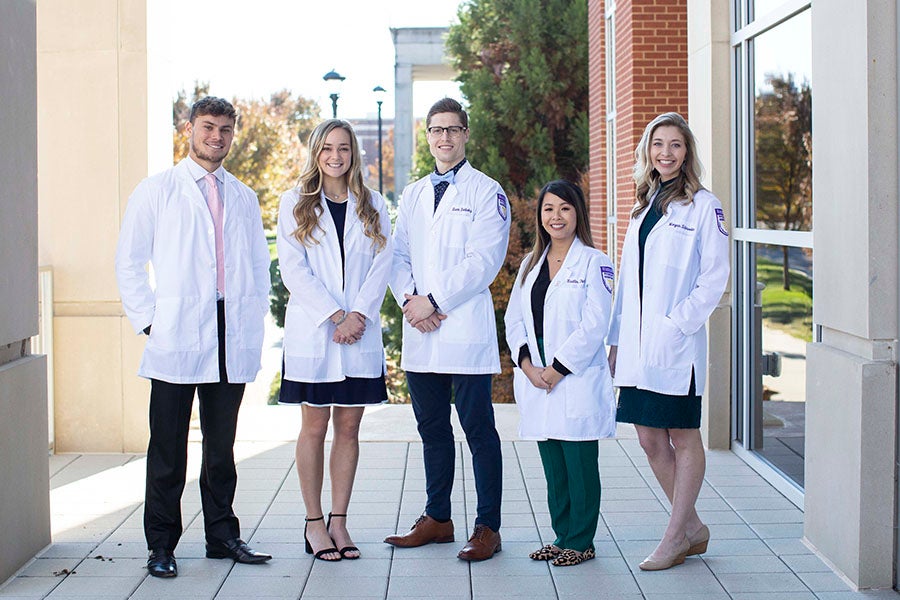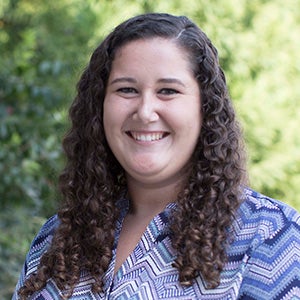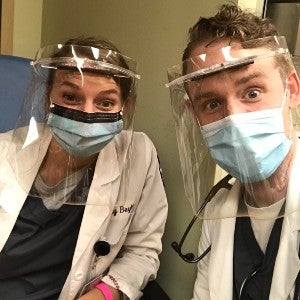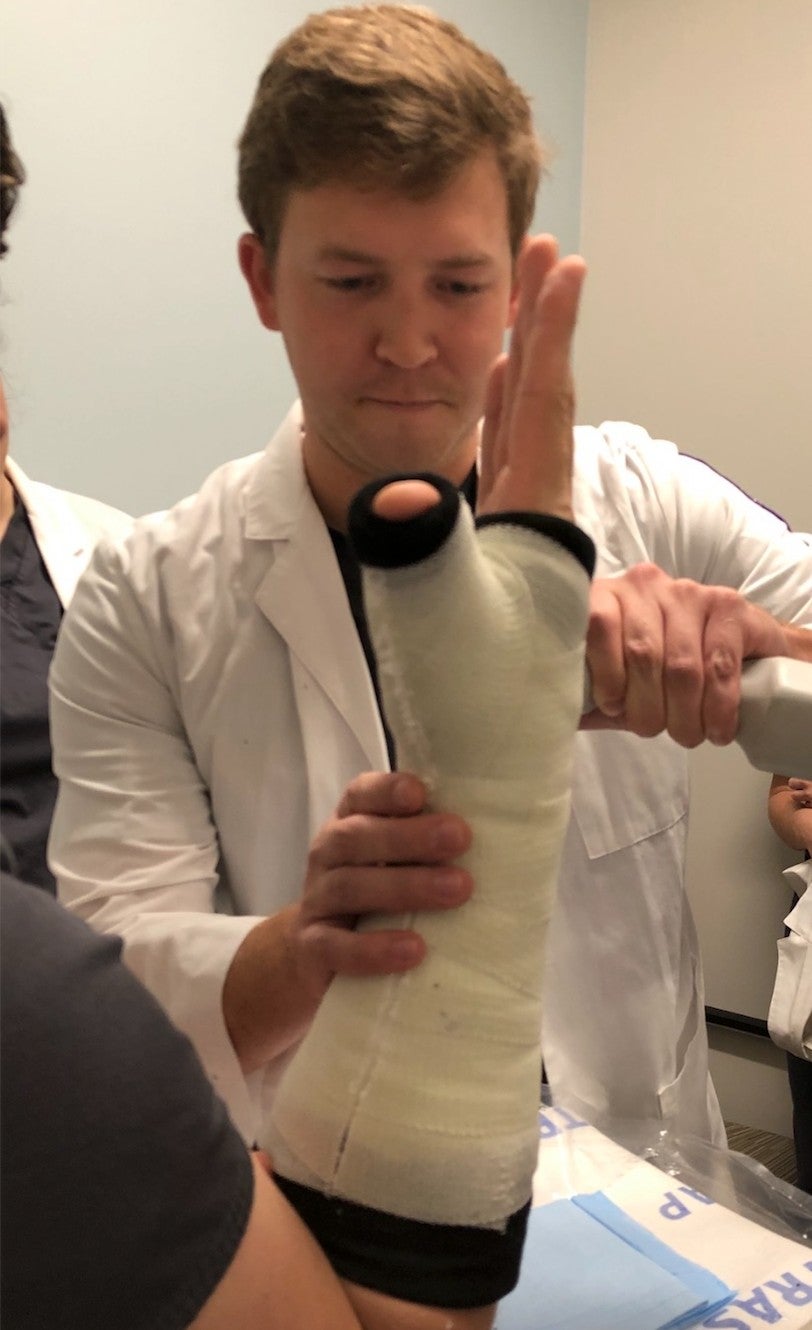Lipscomb’s first PA students get unique clinical experience through pandemic
Students began experiential training in early 2020 with health facilities already addressing COVID-19
Janel Shoun-Smith | 615.966.7078 |

Lipscomb University’s inaugural cohort of physician assistant students were stepping into their first clinical placements in March 2020 when Tennessee began to be impacted by the COVID-19 pandemic.
Without missing a beat, Lipscomb’s first 33 PA students continued to learn and refine their skills even as health facilities began transforming around them to face the novel coronavirus threat.

Jana Reichenberger
Arriving on March 30 for a placement in the emergency room of Tennova Healthcare - Clarksville, Jana Reichenberger of Wichita, Kansas, said the emergency department that normally cares for about 170 patients every day was unusually quiet. However, the patients she did see during her month at the placement were more severely ill. She was able to observe and participate in more serious cases than might otherwise be the case, she said.
On one day she was assigned to perform CPR on a COVID-19 patient. Before the patient arrived by ambulance, Reichenberger was outfitted with an N-95 mask, surgical mask, glass face shield, a hair net and a gown, more than what is normally required for a less critical interaction with a COVID-19 patient, as she would be in extensive and close contact with the patient to provide CPR.
“Just standing there (before the patient arrived) it was hot, then I did the CPR in all the personal protective equipment for about 30 minutes, and it was hard. I can imagine how much harder it would be doing that treatment multiple times a day in that attire. It was exciting and terrifying,” said Reichenberger.
On a more regular basis, Reichenberger took patient histories and served as triage and for patients complaining of a cough (one of the COVID-19 early symptoms), who were restricted to a particular hallway as a waiting room.

Fellow PA student Ashley Best and Ben Crisp
The PA students still had to get suited up in a lesser amount of PPE to assess those patients in “Hallway 19,” said Ben Crisp, of Nashville, a PA student who was also on a rotation at Tennova Healthcare - Clarksville this spring.
The assessment process was different than prior to the pandemic, as the area to report findings and order tests and treatments was a long way from Hallway 19, said Reichenberger, and every provider who interacted with a suspected COVID-19 patient has to record that interaction in a log, Crisp said.
The PA students carried out tests for COVID-19 as well as the flu and strep throat, more common illnesses with similar symptoms, Crisp said.
“As a student I had to learn not to rely on a notebook. I got really good at organizing my thoughts, and doing it quickly and regurgitating what I learned from the patient back to my preceptor,” said Reichenberger.
In a pre-pandemic situation, the emergency room would likely see a flu patient who appears stable and send them home with medication and guidance, Crisp said. But in today’s world, patients who have tested positive for COVID-19 and appear stable are more likely to be admitted to the hospital, as the virus has proven to cause a rapid destabilization among many patients, he said.
“For COVID, you can have a patient who looks pretty healthy, but we would go ahead and take them to the ICU, and within two days, they would be completely different. The speed with which the virus affects them is incredible. You don’t see that very much in medicine,” he said.
“On the opposite side of the spectrum, we saw lots of patients who had confirmed coronavirus and had mild symptoms at best. People come in because they are just uncertain. There wasn’t any correlation between the testing positive and how sick they were.”

Tim Schorkopf at work on a health care rotation.
Tim Schorkopf, a PA student from Franklin, Tennessee, found himself assisting with novel coronavirus testing at Family Health Center of Ashland City on a family health rotation this spring. He did initial assessments and patient histories for the nurses who did the test swabbing and helped determine how to proceed for patients who may have COVID-19 or may have an underlying condition causing problems.
The facility converted its back parking lot into an outdoor testing center. In addition, he treated patients for other ailments while they sat in their cars or over telehealth systems when it wasn’t crucial for them to be seen in-person, especially for issues involving anxiety and depression, he said.
“My physician said that recognizing the value of telehealth will be one positive thing to come out of this pandemic,” Schorkopf noted.
Schorkopf learned to deal with a wide range of attitudes among the drive-up patients, from apathy to heightened fear, he said. He was involved in testing during a time when Tennessee’s health providers were only testing those with emergent symptoms, in order to ration testing supplies. He interacted with many patients who were so fearful they came to their primary care provider for a test, but they had no emergent symptoms.
“They would get mad or annoyed when we couldn’t test them because what they really wanted was some kind of mental relief,” he said. “I think many people were not as worried about themselves as they were about bringing the virus home to their family. They wanted to know they weren’t getting them sick.”
Tennessee’s first reported case of COVID-19 was on March 5, so Reichenberger knew as she headed into her ER rotation that she would have to deal with its effects, both on patients and on the health care system.
“I was a little scared, just because of the unknown,” she said. “Could it kill me? Those thoughts all go through your head. But at the same time, I know I’m going to have to be health care provider in a year, and I will have to work in this environment, and there are not many people who can say they earned their training during a pandemic.
“When I got there and saw all the precautions they were taking and the advice my preceptors gave about wearing the PPE, within the first week it was OK.
“It actually made me feel more like, ‘OK, this is what I want to do.’ I want to help people in times of need. Even if it isn’t COVID. Maybe it is a child with a cut finger who is upset about being in the hospital. I entered the health care field to help people, and I realized this is where I want to be.”